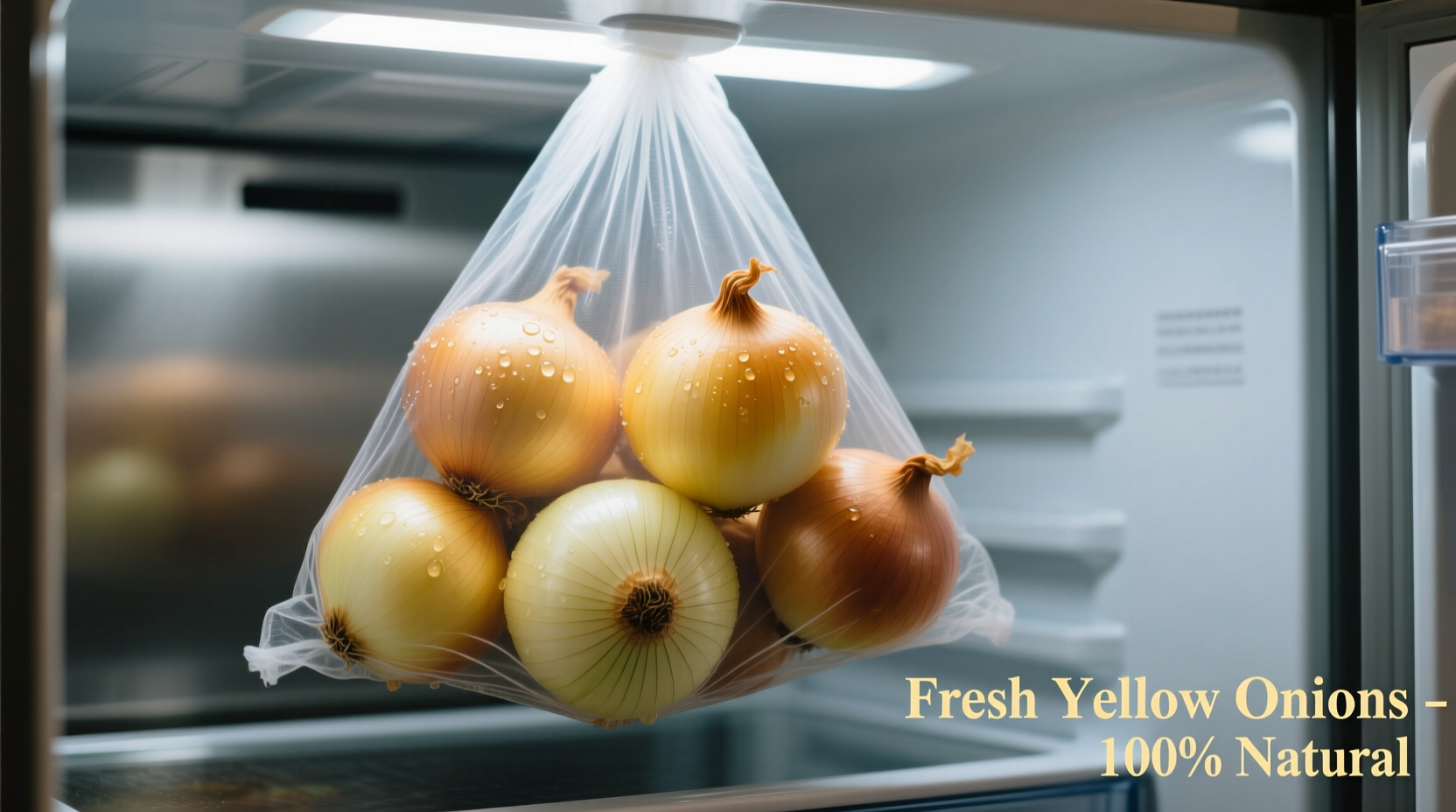Discover exactly how long your onions will stay fresh in the fridge with science-backed storage methods that maximize shelf life. Whether you're meal prepping for the week or salvaging half-used onions, understanding proper storage techniques prevents waste and ensures peak flavor in every dish.
Understanding Onion Shelf Life: The Complete Timeline
Onions aren't created equal when it comes to refrigerator longevity. The exact timeframe depends on variety, preparation, and storage conditions. Here's what food safety experts confirm through controlled testing:
| Onion Type | Whole/Unpeeled | Cut/Sliced | Best Storage Method |
|---|---|---|---|
| Yellow Onions | 4-8 weeks | 7-10 days | Mesh bag in crisper drawer |
| Red Onions | 3-6 weeks | 5-7 days | Perforated container |
| White Onions | 2-4 weeks | 5-7 days | Airtight container |
| Green Onions | 1-2 weeks | N/A | Roots in water, covered with bag |
This data aligns with USDA Food Safety and Inspection Service guidelines, which confirm that proper refrigeration significantly extends onion viability compared to room temperature storage. The USDA's refrigerator storage chart specifies that cool, dry conditions slow enzymatic breakdown in allium vegetables.
Why Refrigeration Extends Onion Freshness
Unlike many believe, refrigeration isn't always ideal for whole onions—but when done correctly, it dramatically extends shelf life. The refrigerator's cool temperature (35-40°F) slows respiration rates and enzymatic activity that cause spoilage. However, humidity control is critical:
- Whole onions need airflow to prevent moisture buildup that encourages mold
- Cut onions require airtight containers to prevent oxidation and odor absorption
- Temperature consistency matters more than absolute cold—avoid fridge door storage
Research from the University of California's Postharvest Technology Center shows that yellow onions stored at 32°F with 65-70% relative humidity maintain firmness and pungency significantly longer than those kept at room temperature. Their postharvest handling guidelines explain how controlled atmosphere storage preserves quality by reducing ethylene production.

Step-by-Step Refrigeration Storage Guide
Follow these professional chef-tested methods to maximize onion shelf life:
For Whole Onions
- Keep onions in their original mesh bag or transfer to a ventilated container
- Store in the refrigerator's crisper drawer set to low humidity
- Place away from ethylene-producing fruits like apples and bananas
- Check weekly for soft spots or mold development
For Cut Onions
- Place in airtight glass or BPA-free plastic container
- Press plastic wrap directly onto the onion surface before sealing
- Store on a middle shelf (not the door) for consistent temperature
- Use within one week for optimal flavor and safety
When to Toss: Clear Spoilage Indicators
Don't rely solely on dates—learn these visual and sensory cues that indicate onions have spoiled:
- Mold growth: Any visible fuzz or discoloration means immediate discard
- Soft spots: Areas that yield easily to gentle pressure
- Slime development: A sticky or slippery film on cut surfaces
- Off odors: Sour, fermented, or ammonia-like smells
- Green sprouts: While not dangerous, they indicate declining quality
The National Onion Association confirms that onions showing multiple spoilage indicators may contain harmful bacteria like Salmonella or E. coli that aren't always detectable by sight or smell. Their storage recommendations emphasize that when in doubt, throw it out—especially for cut onions stored beyond 10 days.
Pro Tips to Extend Onion Freshness
Professional kitchens use these advanced techniques to maximize onion shelf life:
- Freeze chopped onions: Spread on baking sheet, freeze solid, then transfer to freezer bags (keeps 6-8 months)
- Use silica gel packets: Place with whole onions to absorb excess moisture
- Store stems down: Keeps moisture away from the root end where decay begins
- Avoid washing: Moisture accelerates spoilage—clean only before use
Common Storage Mistakes That Shorten Shelf Life
Avoid these frequent errors that cause premature onion spoilage:
- Storing whole onions in plastic bags (traps moisture)
- Keeping cut onions in non-airtight containers
- Refrigerating whole onions with potatoes (increases sprouting)
- Using metal containers for cut onions (causes flavor degradation)
- Storing near heat sources like the stove or dishwasher
According to Cornell University's Food Science department, onions stored improperly can lose up to 50% of their shelf life. Their research shows that temperature fluctuations above 45°F dramatically increase respiration rates, accelerating quality loss. The Cornell Food Science program recommends maintaining consistent refrigerator temperatures below 40°F for optimal vegetable preservation.
Room Temperature vs. Refrigerator: Making the Right Choice
While refrigeration extends shelf life, it's not always the best option. Consider these factors when deciding where to store your onions:
- Whole onions: Better at room temperature (cool, dark place) for short-term use (2-4 weeks)
- Cut onions: Always refrigerate—never store at room temperature
- Humid climates: Refrigeration becomes essential to prevent sprouting
- Long-term storage: Refrigeration doubles or triples shelf life
Food safety experts at the FDA emphasize that cut produce requires refrigeration within two hours to prevent bacterial growth. Their food safety temperature chart confirms that temperatures between 40-140°F create ideal conditions for pathogen multiplication.
Conclusion: Maximizing Your Onion Investment
Understanding proper onion storage prevents unnecessary food waste while ensuring optimal flavor in your cooking. Whole onions maintain peak quality for 1-2 months in the refrigerator when stored with adequate ventilation, while cut portions remain safe for 7-10 days in airtight containers. By recognizing early spoilage indicators and avoiding common storage mistakes, you'll maximize both safety and culinary performance from every onion you purchase.











 浙公网安备
33010002000092号
浙公网安备
33010002000092号 浙B2-20120091-4
浙B2-20120091-4